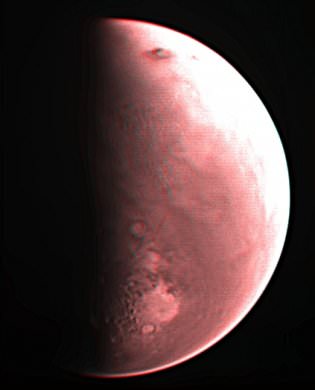[/caption]
The Mars Webcam is back in action after taking a three month hiatus surrounding Mars solar conjunction. If you don’t remember, or if haven’t heard about this “eye on Mars” before, here is a little background: the Visual Monitoring Camera (VMC) is part of the Mars Express spacecraft, ESA’s Mars orbiter. Its original purpose was to provide simple, low-tech images of Beagle lander separation. After the Beagle departed from the orbiter in Dec. 2003 (and subsequently wasn’t heard from again) the VMC was switched off. But in August of 2008 mission planners had the idea of trying to turn the camera back on, and using it as a “webcam,” which ran until December and solar conjunction. The VMC team also has a new blog and they are also looking for the public’s help in processing and cleaning up their images.
The Mars Webcam is not a scientific instrument, but it does provide fantastic views of Mars – including crescent views of the planet not obtainable from Earth.
According to the VMC blog, the scientific team is looking for the public’s help to interpret and rework images, as well as perform a little photo artistry (i.e. Photoshopping) on the images taken by this camera. “We cordially invite you to download any of our images sets and send us your results. We’ll post the best in our public gallery.”
Find more info on how to work with the VMC team here.


Why should we help ESA clean up their precious images? If this were NASA, and the images public domain, I’d surely help. The ESA are totally ungrateful for their public funding and don’t even allow free use of their images by the public who pays for them.
I’ve half a mind to send them shock images. Given the primitive state of image recognition, chances are someone at ESA would get the pleasure of viewing them.
Ron Mexico
Your comment comes across to me as quite unjustifiably bitter.
ESA have pretty much the same image and video usage rules as NASA.
And there are many thousands of great pictures. My favourites are the 3D models of the Martian surface… a lot of work to make, and all for free to use!
@Ron: It’s a shame you blame ESA for something ESA cannot be hold responsible for. ESA does not have any say what-so-ever on the data acquired by the scientific instruments on the ESA spacecraft. While ESA funds and operates the spacecraft, the scientific instruments are funded, built and operated by national research organizations, which are entirely independent of ESA.
In the case of Mars Express, the stakeholders of the HRSC images are the PI, Gerhard Neukum, FU Berlin and the German Aerospace Agency, DLR.
I agree with you that it’s a shame that the images are not released to the public domain, but please put the blame to where it belongs. In fact, ESA is a victim of this unfortunate policy as it wrongly takes the stick over it. People tend not to care too much about the hard facts…
As to the wimpy “webcam” images, however, the copyright is with ESA. And what does ESA do with them images? Releasing them to the public domain.
I think this is an outstanding opportunity to engage the amateur astronomy community & perhaps make an unexpected discovery to boot! In the days following the Huygen probe landing on Titan, amateur astronomers posted stitched together mosaics of Titan’s surface before ESAs’ official release of their mosaics. Pro-am projects like this one, Galaxy Zoo, etc. are surely a win-win situation for astronomy.
@Feenixx: That’s simply not true. If you want to see the difference, just go to Wikipedia. Wonderful images from NASA abound, but there’s hardly anything from any ESA project. Why? The ESA images are free for “educational use,” or sometimes more broadly for “non-commercial use.” Wikipedia can’t accept these terms because they allow republication of their material under a free license, and they can’t place such constraints on any downstream users of Wikipedia content.
The restrictions on ESA images may *seem* slight, but they turn out to be far more burdensome in practice than they are in theory, and there’s the whole matter of them being morally unjustified in imposing them in the first place.
@Cordelia Steiger: I admit I don’t know any of the internal politics of the matter, but one would think ESA would have a determining say over this sort of thing, since those instruments would do a fat lot of good sitting here on the ground without the spacecraft to launch them.